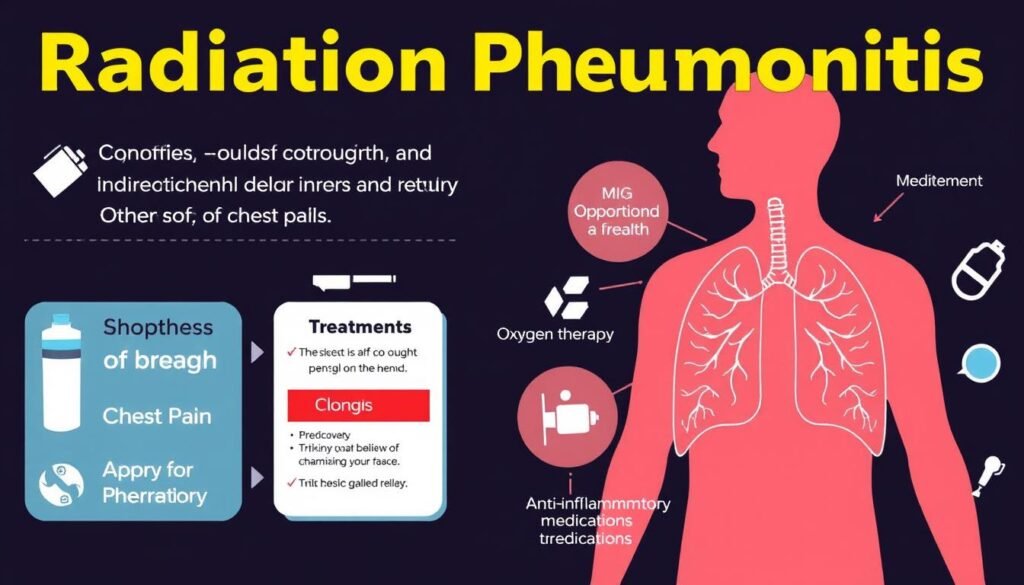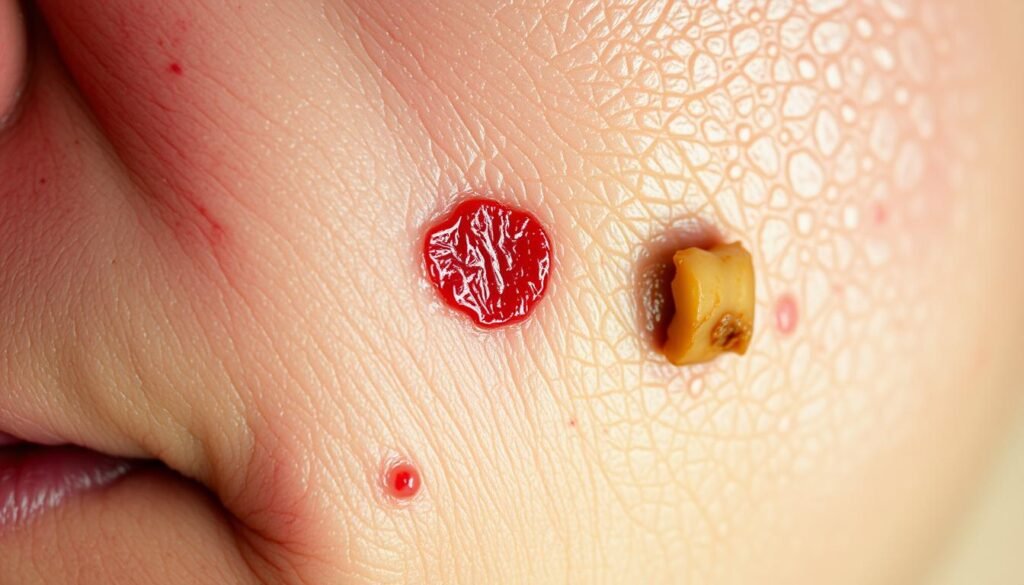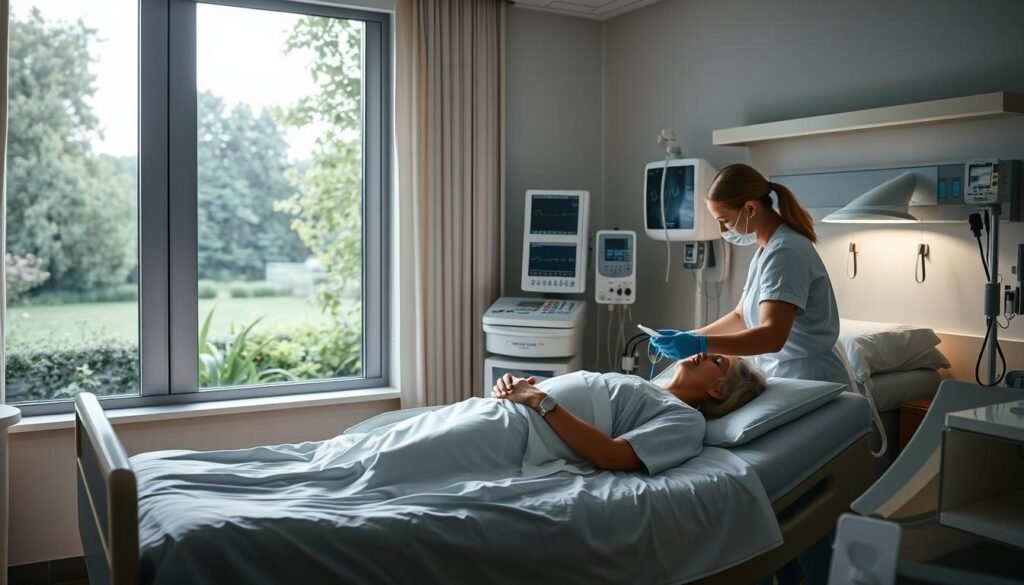About 80% of people getting radiation for lung cancer will face side effects. This therapy is key, especially if the tumor can’t be removed or surgery isn’t possible. Even though it attacks cancer cells, it also causes unwanted effects. These can majorly affect a person’s health and life quality.
Side effects like feeling tired, sick, not hungry, and skin changes are common. They can happen during or after treatment. They affect how a person lives each day. Long-lasting issues, like a constant cough and lung inflammation, can also start. This shows why it’s crucial to know all about what could happen with radiation.
Key Takeaways
- Radiation is often used for lung cancer when surgery isn’t an option.
- About 80% of patients face side effects from the treatment.
- Common issues include tiredness, feeling sick, and less hunger.
- There could be lasting effects like cough and lung problems.
- Telling doctors about all symptoms is very important.
- Knowing side effects helps in dealing with them during treatment.
Understanding Radiation Therapy for Lung Cancer
Radiation therapy plays a key role in lung cancer treatment. It uses strong radiation to attack and destroy cancer cells. This method is essential, with 30% to 50% of cancer patients receiving it. It may be used by itself or with other treatments like chemotherapy and surgery. Knowing about the different ways to do radiation can really help patients.
When it comes to lung cancer, there are mainly two types of radiation therapy. These are External Beam Radiation Therapy (EBRT) and brachytherapy, which is an inside-the-body method. Every year, about 7 million people worldwide get radiation therapy, especially EBRT. EBRT includes several advanced techniques. These are Three-Dimensional Conformal Radiation Therapy (3D-CRT), Intensity Modulated Radiation Therapy (IMRT), and others like Proton Beam Therapy.
The treatment usually needs several visits, depending on the cancer’s size and where it is. Even though radiation therapy aims to get rid of lung cancer, it may have side effects. Patients might feel very tired, have skin issues, or find swallowing hard. Knowing what to expect can help patients and their families get ready for treatment.
Types of Radiation Therapy Used in Lung Cancer Treatment
Radiation therapy is key in treating lung cancer. There are several types of radiation therapy to meet varying needs. The main way is external beam radiation. This sends high-energy X-rays to the tumor from outside the body. Patients usually get this treatment five days a week for five to seven weeks. It aims at the tumor but keeps healthy tissues safe.
Brachytherapy is another method. It places radioactive materials near the tumor. This is great for tumors blocking the airways because it targets the area well. It also protects nearby organs. High dose rate brachytherapy is ideal for lung cancers in crucial spots.
The proton therapy option uses protons for radiation. Its precision helps avoid damage to healthy tissue near the tumor. This makes proton therapy appealing for its lower risk of side effects.
Stereotactic body radiation therapy (SBRT) is another choice. It delivers high radiation doses quickly, usually in 7 to 10 days. This approach works well for some tumors.
For more details on treatment types, check out this resource. Modern technology and personalized plans can improve lung cancer outcomes.
Common Side Effects of Radiation for Lung Cancer
Radiation therapy is crucial for treating lung cancer. But, it comes with challenges. Side effects can seriously affect life quality. Knowing and handling these effects is vital for well-being during treatment.
Fatigue from Radiation Therapy
Many patients report feeling very tired due to radiation. This fatigue can be intense and lasts during the whole treatment. It may take weeks for energy levels to return to normal after finishing radiation. Doing light exercises and sleeping well can help with the fatigue.
Radiation-Induced Nausea
Many people feel very sick from radiation. Not keeping food down makes things worse. It’s important to eat small, regular meals and drink plenty of water to feel better. Medicines and diet changes can help with the nausea.
Changes in Appetite and Weight Loss
It’s common for patients to not feel hungry. This can cause weight loss without trying. Patients work with dietitians to eat right and stay healthy. Balanced meals help deal with appetite loss and keep nutrition up.
Dealing with these side effects means being active in your care. Always talk with your healthcare team for help. To learn more about handling side effects, look for detailed guides.
For more information on this topic, visit here.
Radiation Pneumonitis: Causes and Management
Radiation pneumonitis is an inflammation that often shows up after radiation therapy. It targets those treating lung or breast cancer, lymphomas, thymic tumors, or esophageal cancer. Symptoms may appear as early as one month after treatment or up to a year later. Knowing how to spot and treat these symptoms is key to better patient care.
Symptoms of Radiation Pneumonitis
The severity and length of radiation pneumonitis symptoms can differ greatly. People often experience:
- Persistent cough
- Shortness of breath
- Chest pain
- Fever or malaise
If someone has these symptoms following chest radiation, they should contact their doctor right away. Early treatment is crucial.
Treatment Options for Radiation Pneumonitis
Treating this condition depends on how severe the symptoms are. There are several ways to manage it:
- Prescription of corticosteroids such as prednisone to reduce inflammation
- Use of decongestants to alleviate congestion
- Cough suppressants to minimize persistent coughing
- Bronchodilators to ease breathing difficulties
- Oxygen therapy for those experiencing shortness of breath
People with mild symptoms might not need drugs. Non-drug methods like resting more, sleeping in a propped-up position, and avoiding things that irritate the lungs can also help. It’s important to track symptoms and get treatment early to avoid long-term lung problems.

Radiation Esophagitis: What to Expect
Radiation esophagitis is inflammation in the esophagus from radiation during lung cancer treatment. It leads to symptoms that can disrupt daily life. Knowing the symptoms and making diet changes can really help.
Signs and Symptoms of Radiation Esophagitis
Some symptoms of radiation esophagitis include:
- Difficulty swallowing (dysphagia), especially with solid foods.
- Sore throat, which can be constant and bothersome.
- Painful swallowing, which makes eating and drinking hard.
- Dryness or irritation in the throat, causing discomfort.
Dietary Adjustments to Alleviate Symptoms
Making smart diet changes can help manage symptoms. Patients should try:
- A softer diet with pureed fruits, cooked veggies, and soft grains for easier swallowing.
- Avoiding spicy and hot foods that irritate the throat more.
- Choosing liquids or semi-solid meals like smoothies, soups, or yogurt to lessen discomfort when eating.
- Talking to a nutritionist often to keep up with nutrition needs while tackling eating problems.
These diet changes can make life better during radiation esophagitis treatment by easing symptoms.
Radiation-Induced Skin Damage
Radiation therapy helps treat lung cancer but can cause skin problems. Patients may see mild redness to serious conditions like moist desquamation. It’s important to understand these reactions for better care and healing.
Types of Skin Reactions
Skin reactions vary in severity with radiation therapy. This can impact the treatment experience. Common issues include:
- Dryness and itching
- Redness or darker pigmentation
- Peeling or blistering
- Moist reactions, developing into painful sores
- Photosensitivity causing more irritation
Treatments like chemotherapy and immunotherapy can make skin reactions worse. They may cause rashes and changes in skin color. In serious cases, issues like graft-versus-host disease might happen. Knowing about these effects is key to reducing discomfort and preventing bigger problems.
Managing Skin Complications
There are ways to manage problems from radiation to the skin. Here are some:
- Use moisturizing lotions for dryness
- Apply hydrogel or hydrocolloid dressings for more severe reactions
- Try silicone-based dressings to lessen skin damage
- Keep seeing a skin doctor after treatment to keep skin healthy
Using corticosteroids ahead of time may help avoid severe reactions for some patients. Watching the skin during and after treatment is essential. This should start 1-2 months after finishing radiation. Doing this ensures quick help and aids in skin recovery.

For more information on skin reactions and treatments, a detailed review is available here.
Long-term Effects of Lung Radiation
Patients treated for lung cancer with radiation may face effects long after therapy. A chronic cough and pulmonary fibrosis risk are big concerns. These can deeply affect how a patient lives.
Chronic Cough Associated with Radiation
A chronic cough is a common long-term effect of lung radiation. Patients should watch for any breathing changes. Seeing healthcare providers regularly helps treat symptoms early, improving health outcomes.
Potential for Pulmonary Fibrosis
Pulmonary fibrosis can happen after lung radiation, causing thick, scarred lung tissue. This leads to breathing problems. Early detection through medical checks is key. Patients might need ongoing rehabilitation to feel better.
| Long-term Effects | Symptoms | Management Strategies |
|---|---|---|
| Chronic Cough | Persistent cough, possible shortness of breath | Regular check-ins with healthcare providers |
| Pulmonary Fibrosis | Breathing difficulties, fatigue | Pulmonary rehabilitation, medication |
Strategies to Cope with Side Effects
Dealing with lung cancer treatment side effects means being proactive. This includes talking to healthcare teams and using supportive care. Patients often deal with fatigue, nausea, and stress. Making use of good coping strategies helps improve their well-being.
Consultation with Healthcare Professionals
Talking to healthcare professionals is key to manage side effects well. Oncologists, nurses, and dietitians offer important advice. They understand each patient’s specific needs. By talking openly, patients can share their worries and get help with symptoms. Regular meetings with healthcare teams help adjust treatment plans. This makes coping with the emotional and physical challenges of therapy easier.
Supportive Care Services Available
Supportive care services are vital for cancer patients’ quality of life. These services include:
- Counseling for emotional support and anxiety management
- Nutrition support for appetite loss and dietary changes
- Rehabilitation programs to regain strength and mobility
- Pain management strategies for better comfort
- Support groups to connect with others in similar situations
Using these resources helps patients find coping strategies that work for them. It provides a complete approach to treatment. This way, physical, emotional, and mental needs are all cared for.
| Type of Service | Description |
|---|---|
| Counseling | Provides emotional support and coping strategies for anxiety and stress. |
| Nutrition Support | Offers guidance on dietary choices to combat appetite loss and improve health. |
| Rehabilitation Programs | Aims at physical recovery and strength enhancement during and after treatment. |
| Pain Management | Includes medications and therapies to lessen pain and increase comfort. |
| Support Groups | Connects people facing similar health issues for support and motivation. |
In conclusion, healthcare consultations and supportive care together support effective coping. This allows patients to handle their treatment journey better.
Side Effects of Radiation for Lung Cancer: Personal Stories
Individuals with lung cancer share stories that highlight both emotional and physical challenges. Rick was diagnosed with stage 3 lung cancer in 2010. He went through seven weeks of radiation and chemotherapy. Despite various treatments over years, his cancer spread to his sternum by 2016. This led to more treatments, including stereotactic radiotherapy for new metastasis on his right lung.
These stories share common themes and coping strategies. Survivors find strength in connecting with others in similar situations. Their experiences offer hope and insights to those newly diagnosed. They share tips on managing emotions and advocating for lung cancer awareness.
One story talks about a veteran addressing the high lung cancer risks in the military. Another story reveals lung cancer’s impact on three generations of women. These accounts show the disease’s unpredictability and persistence.
Bill discusses the benefits of biomarker testing in finding the right treatment. Through their stories, survivors treat lung cancer as a chronic condition. They provide hope and guidance for life after treatment.
These stories, focusing on radiation side effects and treatment, make lung cancer feel more real and personal. They foster a supportive community. This enables patients to share their experiences, increasing awareness and understanding of the disease.
When to Contact Your Healthcare Team
Patients getting lung cancer radiation therapy need to watch their health closely. It’s important to know when to contact the healthcare team to manage side effects well. If you face severe or unexpected symptoms like intense tiredness, trouble eating, or serious skin issues, reach out to your doctors right away.

Increased tiredness is common during treatment, says the Canadian Cancer Society. Getting enough sleep can lessen this tiredness. Also, radiation might affect your eating habits, especially if your abdomen or head and neck are treated.
Radiation may make your skin more sensitive. It’s key to use gentle care to avoid irritation. Choose soft fabrics like cotton and silk instead of rough ones. If you’re getting breast radiation, skipping underwire bras can help ease discomfort.
Talking to your healthcare team is crucial if you have symptoms like trouble swallowing or breathing. These could mean your treatment needs adjusting. Those with radiation to the head and neck should also get regular dental checkups. This helps avoid tooth decay and infections.
| Side Effect | When to Contact Healthcare Team |
|---|---|
| Fatigue | When extreme tiredness interferes with daily activities |
| Difficulty Swallowing | If symptoms worsen or affect nutrition |
| Skin Reactions | For increased redness, irritation, or pain |
| Shortness of Breath | When breathing difficulties arise, signaling potential acute issues |
| Dental Problems | For any signs of infection or cavities |
Staying informed and proactive helps patients have a better experience with radiation therapy. This ensures timely help and reduces complications.
Conclusion
Radiation therapy is key for treating lung cancer, especially for those who can’t have surgery. It targets tumors well. But knowing about possible side effects is important. Patients should learn how to deal with these effects.
Support and talking with doctors help a lot in this treatment. It’s crucial to understand how to manage the treatment. This understanding improves life quality. New techniques like IMRT and proton therapy are better at targeting cancer. They help in reducing bad effects in the long run.
Resources like support groups are there for people going through lung cancer treatment. These help in handling side effects. You can find great advice on coping strategies at this link. Being active in your care helps make the treatment journey better. It lessens the negative effects on your health.